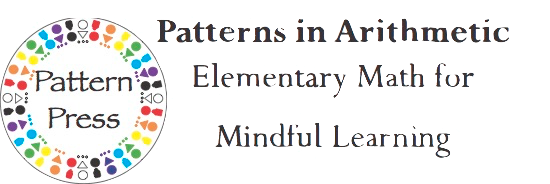

Patterns in Arithmetic is the math program developed at the UCI Farm Elementary School for elementary aged students and now also published with adult learners in mind. At the heart of mathematics is the idea of patterns. Mathematicians are people who find and use patterns in numbers, shapes, and relationships, exploring through these patterns the workings of the world and universe. Mathematicians also explore patterns simply for their beauty and for the great pleasure discovering patterns can give.
This mathematics program aims to teach students and their teachers to think like mathematicians, not just memorize some of the things that mathematicians have found out. Students "do" mathematics from the beginning, so there is an emphasis on inquiry and discovery, on invention, and on learning what genuine understanding feels like and how to achieve it.
Students create their own methods for solving arithmetic problems. They use concrete materials to build and prove their answer. Then they are asked to solve it a different way and to verify that answer. The goal is understanding: knowing what it feels like when one understands (which often is accomplished through "Aha" flashes of insight); knowing what it feels like when one does not understand and what to do then; learning perseverance and how to push through feelings of uncertainty and frustration.
Learners create, routinely look for, and discover patterns in numbers, shapes, the sky, the world. They invent problems for themselves and others, estimate, predict, and look for answers that make sense; they develop heuristics (practices that help them solve problems, e.g., draw a picture), and look for relationships (the more the more).
Ideally they develop the meta-skills of a good mathematician: the 'understanding' loop: They know when they understand and when they don't, and they keep at it until they do; the 'conjecture and test' loop: They sense when something can be generalized and press to the limit of their ability to do so.
The Parent/Teacher Guide scripts the lesson to create this learning interaction. Ultimately, the learner will ask herself these thinking questions.
The following process is used throughout the Patterns in Arithmetic series to develop understanding of a concept:
1. Introduce the concept with a manipulative.
Orally discuss it. Build it. Verify it. Practice
it. Repeat the experience with a different
manipulative (oral manipulative).
2. Use manipulatives to explore the concept
again. This time record it with pictures (picto-
rial representation). Practice it. Use worksheets.
3. Record the problem with numbers (abstract,
symbolic), which links the concrete to the
pictorial to the abstract.
4. Practice to fluency.
5. Practice for speed.
